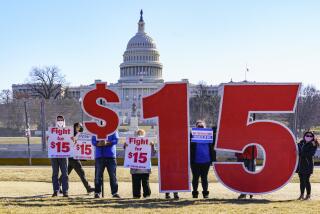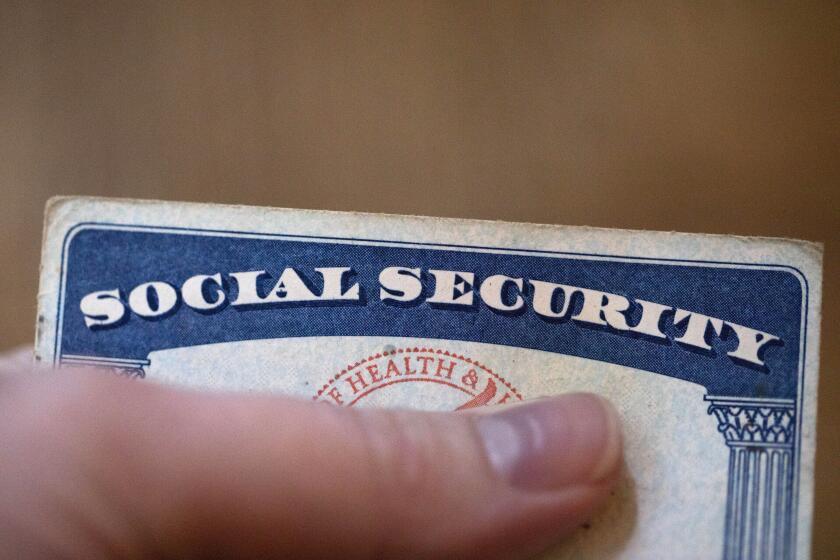A new dawn for the minimum wage

Audience members celebrate at a May 19 meeting where the Los Angeles City Council supported raising the city’s minimum wage to $15 per hour.
What has long been a hypothetical question may soon become a real one: What would the national economy look like with a $15-an-hour minimum wage?
Community activists and politicians see a $15 minimum wage as the antidote to the ills of rising inequality, a way to reduce poverty and stimulate the overall economy. Business owners warn it will tie their hands in downturns, drive small employers out of business and lead to millions of layoffs.
The reality is not that simple: An increase to $15 an hour would ripple through the U.S. economy in some unexpected ways that are, generally, not as bad nor as beneficial as each side claims.
NEWSLETTER: Sign up for a weekly briefing on California business news
The push for a higher minimum wage has gained momentum over the past few years. Seattle, San Francisco and most recently Los Angeles have adopted a floor of $15 an hour to take effect over the next few years. That’s more than double the current federal minimum-wage law of $7.25.
Other cities such as Chicago. Oakland and Washington, D.C., have raised the minimum wage, but not as much. At least a dozen other cities and states, including New York and Oregon, may soon follow.
The recent movement is rooted in years of stagnant wages and a general disaffection from the slow and uneven recovery since the Great Recession officially ended in 2009. Like the Gilded Age in the late 1800s, the last quarter-century has seen fabulous income gains for corporations and individuals at the top, but very little for everybody else.
It’s true that higher minimum wages would address some of that inequality, lifting many Americans from poverty.
Almost 60% of workers who are paid on an hourly basis — some 44 million people — currently make less than $15 an hour, Labor Department figures show. If the minimum went up to $15 tomorrow, nearly half of those workers would get at least a 50% bump in pay.
And it’s not just teenagers and young adults who would benefit. More than 8.4 million people earning less than $10 an hour today are in the prime of their work life, between ages 25 and 54. About 62% of these workers are women, many with children.
Yet the benefits from higher wages would be offset for many by a reduction in government benefits that low-wage workers now receive, such as child-care subsidies or public aid for food, housing and medicines.
Millions of workers would have more money in their pockets to spend, boosting demand for goods and services. But they would also likely face increased prices in the marketplace as retailers, restaurants, child-care centers and other businesses that employ low-wage workers shift the higher labor costs to their customers.
When Oakland’s minimum wage jumped from $9 an hour to $12.25 in March, residents noticed many stores tacked on a dime or a quarter to an assortment of items. Creole food caterer David Smith went further, jacking up the price of his dishes by $2 to $3 a plate. “I had to,” says Smith, 35, who has three employees.
Longer term, many low-paid workers could lose their jobs or find fewer openings as employers cut back to cope with the higher wage requirements.
An analysis by the nonpartisan Congressional Budget Office last year estimated that raising the minimum wage to $10.10 an hour, which some lawmakers had proposed, would result in a half-million jobs lost. At $15 an hour, the hit would likely be in the millions.
“Fifteen dollars still scares me,” says Harry Holzer, a Georgetown University economist, adding that what might be doable in high-priced cities like Seattle and San Francisco could prove more difficult in other areas.
No doubt higher wages will push some struggling companies into bankruptcy, especially smaller ones that operate on thin margins.
But other businesses will do just fine, maybe even thrive, with improved productivity and greater sales generated as weaker rivals fold and consumers pump more money into the economy.
Some businesses will adapt by outsourcing more. Others will try to speed up automation and substitute labor with machines, shrinking lower-wage jobs in the process but also adding some higher-paying ones to handle new technologies.
How all of these competing forces play out is anybody’s guess. But as the push for higher minimum wages spreads, workers and employers are already beginning to envision life in a $15-an-hour world.
Times staff writer Tiffany Hsu in Los Angeles contributed to this report.
READ MORE ON THE MINIMUM WAGE DEBATE:
Hardware store owner says raising pay resulted in better workers
For this McDonald’s cook, wage hike could be more harm than help
This dishwasher must choose between shoes for sons or paying phone bill
Child-care worker sees hours cut when Oakland’s minimum wage was raised
More to Read
Inside the business of entertainment
The Wide Shot brings you news, analysis and insights on everything from streaming wars to production — and what it all means for the future.
You may occasionally receive promotional content from the Los Angeles Times.










